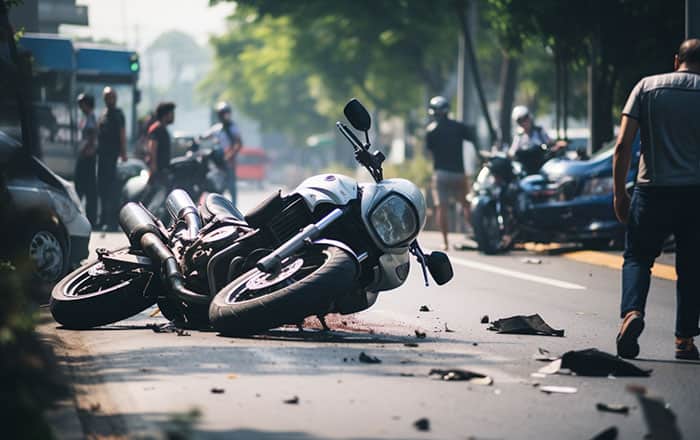Understanding Motorcycle Accidents: Determining Fault and Legal Implications

Motorcycle accidents can have devastating consequences, often resulting in severe injuries or even death. It is common for drivers to blame motorcycle riders for most accidents, with many assuming that it is the riders’ fault. However, this is far from the truth. Among the various types of accidents, understanding at-fault motorcycle accidents is crucial for identifying the causes, preventing future incidents, and navigating legal and insurance processes. Studying the factors contributing to these accidents and exploring their implications can provide riders with valuable insight that promotes safer riding. We will examine the underlying causes, legal considerations, and prevention strategies of at-fault motorcycle accidents in this comprehensive analysis.
Defining At-Fault Motorcycle Accidents

Explanation of the concept of at-fault accidents in the context of motorcycle riding
At-fault motorcycle accidents refer to incidents where the rider bears primary responsibility for the collision or the resulting consequences. Understanding the nuances of fault attribution is essential for accurately assessing liability, determining legal repercussions, and establishing fair compensation in the aftermath of an accident.
Differentiating between at-fault accidents and no-fault accidents
While at-fault accidents involve a clear attribution of responsibility to the rider, no-fault accidents occur when the cause of the collision is deemed beyond the control of any involved party. Distinguishing between these two types of accidents is vital for evaluating the legal and insurance implications associated with each scenario.
Importance of determining fault in motorcycle accidents for legal and insurance purposes
Determining fault in motorcycle accidents serves as a crucial factor in legal proceedings and insurance claims. It influences the allocation of liability, impacts potential compensation, and plays a pivotal role in negotiating settlements. Analyzing the contributing factors that lead to at-fault accidents enables us to develop strategies for accident prevention and encourages responsible riding practices.
Contributing Factors to At-Fault Motorcycle Accidents

| Contributing Factors | Description |
|---|---|
| Lack of proper training and experience | Insufficient training and inexperience can significantly contribute to at-fault motorcycle accidents. Riders who have not undergone formal riding education programs may lack essential skills, such as proper braking techniques, cornering, and hazard recognition. This knowledge gap increases the likelihood of errors and poor judgment on the road. |
| Speeding and reckless riding | Excessive speed and reckless riding behaviors, such as weaving through traffic or performing dangerous maneuvers, are common factors in at-fault motorcycle accidents. These actions reduce the rider’s ability to react to unexpected situations and increase the chances of losing control over the motorcycle. It is important for riders to adhere to speed limits and exercise caution while riding. |
| Impaired riding (e.g., under the influence of alcohol or drugs) | Operating a motorcycle while under the influence of alcohol or drugs significantly impairs a rider’s judgment, coordination, and reaction time. Intoxicated or drug-impaired riders are more prone to making critical errors, leading to at-fault accidents with severe consequences. It is essential to never ride a motorcycle while impaired and to always prioritize sober and responsible riding. |
| Poor road conditions and infrastructure | Road conditions play a vital role in motorcycle safety. Poorly maintained roads, potholes, uneven surfaces, and inadequate signage can all contribute to at-fault accidents. These factors increase the risk of loss of control, especially during maneuvers such as braking or turning. It is important for riders to be aware of the road conditions and adjust their riding accordingly, while authorities should prioritize maintaining safe road surfaces and clear signage for motorcycle riders. |
| Inclement weather conditions | Adverse weather conditions, such as rain, snow, or fog, pose additional challenges for motorcycle riders. Reduced visibility, slippery surfaces, and compromised traction increase the likelihood of at-fault accidents. Riders must adjust their riding style and exercise caution when faced with inclement weather. It is advisable to ride at reduced speeds, maintain a safe distance from other vehicles, and wear appropriate gear to enhance visibility and traction in adverse weather conditions. |
| Negligent or distracted driving by car and truck drivers | Negligent or distracted driving by car and truck drivers poses a significant threat to motorcycle riders. Inattentiveness, failure to check blind spots, and distractions such as mobile devices can result in collisions where the fault lies with the other vehicle driver. It is important for all drivers to remain attentive and aware of their surroundings, particularly when sharing the road with motorcycles. |
| Failure to yield right of way | At-fault accidents can occur when other road users fail to yield the right of way to motorcycles. This may happen at intersections, during lane changes, or when vehicles enter or exit driveways or parking lots without proper observation. It is crucial for all road users to respect the right of way of motorcycles and ensure proper communication and observation when sharing the road. |
| Lane-Splitting and merging errors | Improper lane-changing and merging maneuvers by other road users can lead to at-fault accidents. Failure to check blind spots, sudden lane changes, or misjudgment of the motorcycle’s speed can result in collisions where the fault lies with the other vehicle driver. It is important for all drivers to exercise caution, use turn signals, and be aware of motorcycles when changing lanes or merging. Motorcycle riders should also be mindful of their visibility to other drivers and exercise defensive riding techniques. |
Understanding Partial Fault in Motorcycle Accidents
While the above factors establish how other drivers can be at fault in motorcycle accidents, it’s important to understand that the motorcyclist can also be partially at fault. This is where the concept of “comparative negligence” comes into play. According to comparative negligence laws, more than one party can be at fault in an accident. An injured person can recover damages if they are less than 50% at fault. However, if they are 50% or more at fault, they cannot recover damages.
Building a Motorcycle Accident Claim
If you’ve been involved in a motorcycle accident, there are certain steps you can take to protect your rights and build a strong claim:
- Report the accident to the police.
- Ensure an accident report is created.
- Document the accident scene with photographs.
- Seek medical attention immediately.
- Keep a record of all medical bills and other evidence of your damages.
- Consult with a lawyer as soon as possible.
Remember, the process of proving fault in a motorcycle accident can be challenging. However, with the right legal support, you can fight for the compensation you deserve.
Preventing At-Fault Motorcycle Accidents

Importance of formal riding education programs
Enrolling in formal riding education programs can significantly enhance a rider’s skills, knowledge, and overall safety awareness. These programs provide comprehensive training on motorcycle handling, defensive riding techniques, and traffic awareness. By investing in proper education, riders can reduce the likelihood of at-fault accidents.
Continuous learning and skill development
Motorcycle riders should recognize that learning is an ongoing process. Regularly refreshing their knowledge and honing their skills through advanced training courses or workshops can help riders stay updated on the latest safety practices and improve their ability to mitigate potential risks.
Situational awareness and anticipating potential risks
Developing a heightened sense of situational awareness is crucial for motorcycle riders. This involves constantly scanning the road, checking mirrors, and being proactive in identifying potential hazards. By anticipating risks, riders can make well-informed decisions and respond effectively to prevent at-fault accidents.
Effective use of protective gear and motorcycle safety features
Wearing proper protective gear, such as helmets, armored jackets, gloves, and boots, is essential for minimizing injuries in the event of an accident. Additionally, utilizing motorcycle safety features like anti-lock braking systems (ABS) and traction control can improve overall stability and control, reducing the likelihood of at-fault accidents.
Advocating for increased awareness among other road users
Promoting awareness and understanding among other road users about motorcycles is crucial for preventing at-fault accidents. Encouraging campaigns and initiatives that educate drivers about the unique characteristics and vulnerabilities of motorcycles can foster a safer and more accommodating road environment.
Encouraging mutual respect and understanding between riders and drivers
Fostering a culture of mutual respect and understanding between motorcycle riders and other road users is essential. Both riders and drivers should adhere to traffic laws, avoid aggressive behaviors, and maintain clear communication on the road. By promoting a cooperative environment, the risk of at-fault accidents can be significantly reduced.
Case Studies and Real-Life Examples

To gain deeper insights into the dynamics of at-fault motorcycle accidents, let’s delve into real-life case studies from different scenarios and locations. By meticulously examining these incidents, we can understand the unique challenges riders face and the various factors that contribute to these accidents. Each case study provides a snapshot of the complexities involved, offering a valuable opportunity for analysis and learning.
- Case Study 1: Intersection Collision In this case, a motorcyclist collided with a car at an intersection, resulting in severe injuries. By studying the traffic flow, traffic light timings, and the actions of both the rider and the car driver, we can explore the role of situational awareness and decision-making during critical moments. Analyzing this incident sheds light on the importance of defensive riding at intersections and the need for drivers to watch for motorcycles.
- Case Study 2: Speeding on Curvy Roads This case involves a rider losing control on a series of sharp curves, leading to an at-fault accident. By studying road conditions, the rider’s speed, and their cornering techniques, we can understand how excessive speed and lack of cornering skills can significantly increase the risk of accidents. This study emphasizes the importance of responsible riding on winding roads and being mindful of speed limits.
Valuable lessons
- Learning to Anticipate Hazards: By examining the mistakes made in each case, riders can better anticipate potential hazards and develop strategies to avoid them. Proper training can empower riders to be more aware of their surroundings and potential risks.
- Strengthening Defensive Riding Skills: Defensive riding techniques are critical in avoiding at-fault accidents. Analyzing these cases can highlight the effectiveness of defensive riding in mitigating risks and enhancing overall safety.
- The Role of Road Conditions: Poor road conditions can play a substantial role in motorcycle accidents. By studying the impact of road quality in these case studies, riders can better navigate hazardous road conditions and adapt their riding accordingly.
- Advocacy and Awareness: Some case studies may reveal the need for increased advocacy and awareness among both riders and other road users. By advocating for motorcycle safety and fostering a culture of mutual respect, we can work towards reducing the frequency of at-fault accidents.
By presenting these case studies and analyzing the key lessons learned, we aim to emphasize the practical application of expert knowledge in preventing at-fault motorcycle accidents. Expertise in rider education, defensive riding, and an understanding of accident patterns can significantly contribute to reducing accidents and creating safer road environments.
In conclusion in this comprehensive analysis, we have explored the concept of at-fault motorcycle accidents, examining the factors contributing to their occurrence, the legal implications involved, and strategies for prevention. We have highlighted the significance of rider education, defensive riding techniques, and promoting awareness among all road users to foster a safer riding environment.
Also understanding at-fault motorcycle accidents is essential for riders to mitigate risks, navigate legal proceedings, and protect themselves and others on the road. By recognizing the contributing factors and implementing preventive measures, riders can significantly reduce the likelihood of being involved in at-fault accidents.
As riders, it is our responsibility to prioritize safety, adopt defensive riding practices, and continually expand our knowledge and skills. By embracing a proactive approach to safety, riders can not only protect themselves but also contribute to a culture of responsible riding that enhances the overall safety of the motorcycle community and the roadways we share.
FAQs
Are motorcyclists usually at fault?
Motorcycle accidents, like any other type of accident, can involve various factors, and fault is not always attributed solely to the motorcyclist. Determining fault depends on the specific circumstances of each accident.
Are most motorcycle crashes the car’s fault?
Motorcycle accidents can involve multiple parties, and fault can be assigned to either the car driver or the motorcyclist, depending on the situation. There is no blanket statement that attributes most motorcycle crashes to the car’s fault.
How likely are you to be in a motorcycle accident?
The likelihood of being in a motorcycle accident depends on various factors, including riding behavior, experience, road conditions, and other drivers’ actions. Being a vigilant and skilled rider, wearing proper safety gear, and following traffic rules can reduce the risk.
Are motorcycle accidents worse than car accidents?
Motorcycle accidents tend to result in more severe injuries compared to car accidents due to the lack of external protection for motorcyclists. However, the severity of any accident depends on the specific circumstances and the forces involved.
Do most people survive motorcycle accidents?
The survival rate in motorcycle accidents can vary based on factors like speed, impact, safety gear usage, and emergency response time. While many motorcyclists do survive accidents, some may sustain serious injuries.
What type of motorcycle is involved in the most accidents?
There is no single type of motorcycle that is universally involved in the most accidents. The likelihood of an accident can depend on factors like rider behavior, road conditions, and traffic situations.
Where is the most likely place for a motorcycle accident?
Motorcycle accidents can occur anywhere, but some common locations include intersections, urban areas with heavy traffic, and winding roads. Awareness of potential hazards can help reduce risks.
What is more dangerous for motorcyclists than for drivers?
Motorcyclists face higher risks of severe injuries due to the lack of protective barriers around them. Motorcyclists are more vulnerable to external forces and impacts, making it crucial for them to prioritize safety measures.
What color motorcycle has the most accidents?
There is no direct correlation between motorcycle color and accident rates. The color of a motorcycle is not a significant factor in accident occurrence. Safe riding practices and visibility are more critical for accident prevention.
- Tackling the Fear of Motorcycles: A Must-Read for Every Rider - April 25, 2024
- Motorcycle Lost All Electrical Power While Riding - December 10, 2023
- Motorcycle Safety Tips for New Riders - November 23, 2023




